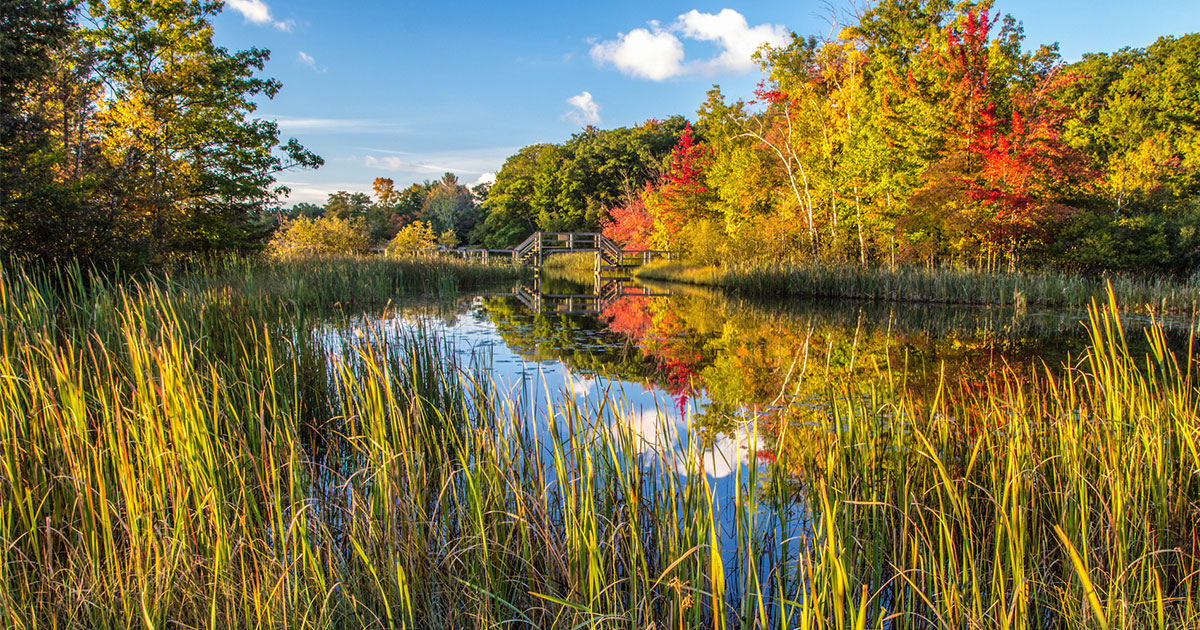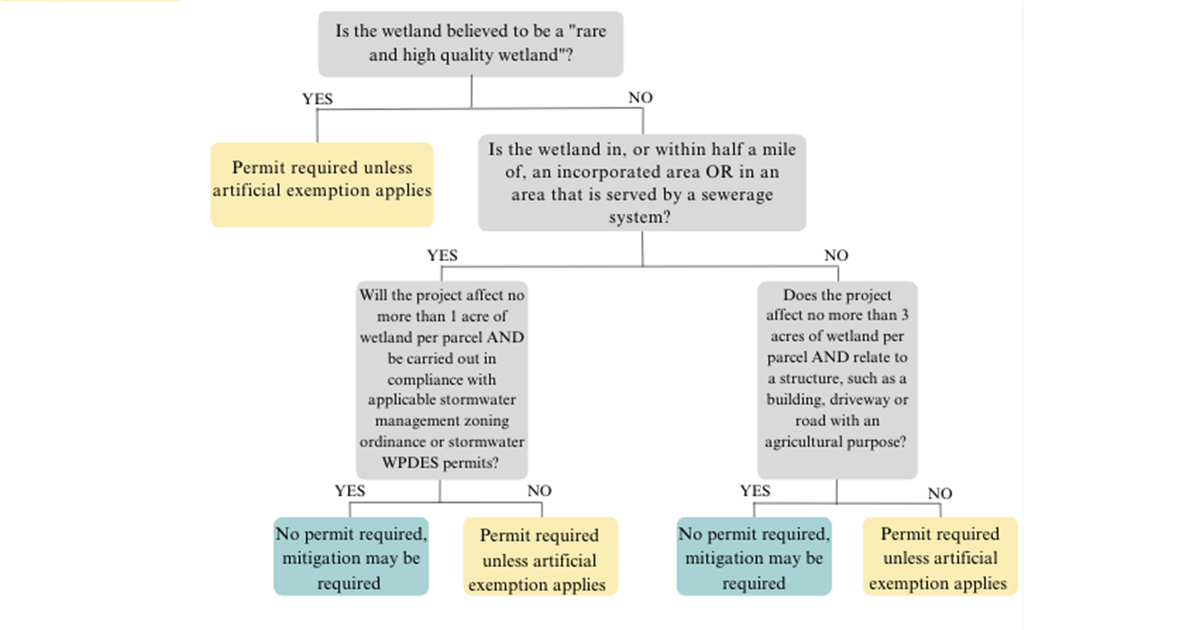
In the wake of the U.S. Supreme Court’s
Sackett v. EPA decision,1 the landscape of wetland protections in Wisconsin has changed.
While Wisconsin boasts robust wetland protection statutes
compared to other states, a significant exemption to the permitting regime within those statutes hinges on the federal definition of wetlands. The “nonfederal exemption,” established by
2017 Wisconsin Act 183, is an exemption to the permit requirement when filling or discharging into certain wetlands that are not covered under the Clean Water Act (CWA).
As the
Sackett decision altered the test for determining a CWA wetland, the attainability of the nonfederal exemption under state law has broadened.
This article aims to explore the ramifications of the
Sackett ruling on Wisconsin's wetlands, while acknowledging that the true magnitude of the decision remains uncertain and that it may take considerable time before the full extent of the change becomes clear.
The ‘Continuous Surface Connection’ Test
In
Sackett, the Court decided on the “continuous surface connection” test for determining if the CWA covers an adjacent wetland.2
As a result, the CWA now encompasses only those wetlands that are “as a practical matter indistinguishable from waters of the United States.”3 More specifically, the new test states that the CWA covers a wetland if:
the body of water adjacent to the wetland is a water of the United States; and
the “[w]etland has a continuous surface connection with that water, making it difficult to determine where the ‘water’ ends and the ‘wetland’ begins.”4
Prior to
Sackett, the 2006 case
Rapanosv. United States presented two tests for determining the CWA’s applicability to wetlands:
First, the prevailing test that came out of the decision was the “significant nexus” test. This test stated that the CWA only covers wetlands if they have a significant nexus to waters of the United States (WOTUS).5
Second, the “continuous surface connection” test suggested that the CWA applies only if the wetland is indistinguishably connected to a WOTUS on the surface.6
Subsequently, both the Obama and Trump administrations enacted rules – the
2015 Clean Water Rule and the
2020 Navigable Waters Protection Rule, respectively – to delineate protections for wetlands adjacent to WOTUS. Although the 2020 rule offered fewer protections than the 2015 rule, both interpreted the CWA to protect at least some wetlands that lacked a continuous surface connection to a WOTUS.
Now, these protections face uncertainty after the
Sackett ruling replaced the significant nexus test with the continuous surface connection test.7
Impact Still Uncertain
Despite the
Sackett decision, the precise impact on Wisconsin's wetland regulations remains uncertain.
Wisconsin has its own well-established wetland regulation framework – most recently updated by 2017 Wisconsin Act 183 – that has long been more robust than its federal counterpart. That law is not changing, meaning that Wisconsin is largely insulated from
Sackett.
Nevertheless, there is one aspect of Wisconsin's wetland permitting program that the decision certainly affects. In Wisconsin, filling, excavating, grading, clearing, or altering a wetland typically requires a general or individual permit unless one of two exemptions applies.
The first exemption is the
artificial wetland exemption, which applies to wetlands resulting from human modification and lacking any wetland history prior to August 1991.
The second exemption, of concern here, is the
nonfederal wetland exemption, which comes into play when the wetlands are deemed “non-jurisdictional” by the U.S. Army Corps of Engineers (USACE). A non-jurisdictional determination indicates that the wetland is not subject to regulation under federal law (i.e., not covered by the CWA).
USACE will utilize the test from
Sackett in forthcoming wetland delineations. Accordingly, the
Sackett decision will broaden the attainability of the nonfederal exemption in Wisconsin.
Permitted Requirements Still Apply
It is important to highlight that, even with this broadened attainability, certain permitting requirements still apply in Wisconsin.
First, if the wetland in question is “rare or high quality,” a permit is always necessary.
Furthermore, there are exceptions within the nonfederal exemption framework. In urban settings, any project impacting
one acre or more of wetland per parcel will require a permit. Similarly, in rural areas, a permit will be mandated for any project impacting
three acres or more of wetland per parcel.
These acreage thresholds ensure that the largest wetland impacts are subject to regulatory oversight, despite the nonfederal exemption (see
Figure 1).

Figure 1: Nonfederal exemption decision tree following a non-jurisdictional determination.
Data from the Wisconsin Department of Natural Resources (DNR) indicates that the nonfederal exemption was granted to projects that totaled 96 acres during the years 2020 to 2022 (approximately 72 football fields’ worth). This is equivalent to more than half of the 185 acres impacted by both general and individual permits, and accounts for 13% of all permanently filled wetlands over that same time period. These proportions are expected to increase due to the
Sackett decision.
Still, the exact implementation of the “continuous surface connection” test remains uncertain, because USACE will be bound by federal rules and future court decisions, which could affect its application.
However, there is an anticipated increase in non-jurisdictional determinations by USACE and a subsequent rise in the granting of nonfederal exemptions under state law. The exact extent of this increase is unknown, yet it is crucial to recognize that each acre of compromised wetland represents a loss for the people and environment of Wisconsin.
Wetlands are Vital Ecosystems
Wetlands are unique ecosystems characterized by waterlogged or saturated conditions that support aquatic or hydrophytic vegetation. They play a crucial role in
water quality by acting as natural filters, trapping sediment, and absorbing excess nutrients, thereby preventing pollutants from reaching downstream water bodies.
Wetlands also provide
habitat for endangered species, offering shelter, food, and breeding grounds for numerous plants, mammals, birds, and amphibians.
Additionally, wetlands serve as natural buffers for
flood control, absorbing excess water during heavy rainfall and reducing the risk of downstream flooding. They act as valuable
carbon sinks, sequestering and storing significant amounts of carbon dioxide, thus mitigating climate change by reducing greenhouse gas emissions.
Wetlands also offer
recreational opportunities, attracting birdwatchers, anglers, boaters, and nature enthusiasts. The combination of water quality improvement, biodiversity support, flood control, carbon storage, and recreational value underscores the importance of wetlands as essential components of our natural environment.
Wisconsin boasts a rich
diversity of wetland ecosystems, including marshes, swamps, bogs, and floodplain wetlands, which form a substantial part of the state's geography. However, the state has witnessed a significant decline in wetlands over time
due to various infrastructure and agricultural projects.
Out of the original 10 million acres of wetlands, Wisconsin has
lost approximately 50%, with the majority of the remaining 5 million acres located in the northern region. These statistics highlight the urgent need for preserving and protecting the remaining wetlands in the state.
It is Still Necessary to Obtain Permits
The bottom line is that obtaining permits remains necessary for discharging into or filling wetlands, except for cases involving artificial or nonfederal wetlands. To secure a nonfederal exemption, one must first obtain a non-jurisdictional determination from USACE, followed by an exemption confirmation from the DNR.
However, the current situation leaves uncertainty regarding the attainability of the non-jurisdictional determination. Additional lawsuits and rulemakings will likely arise to bring clarity to the intricate landscape of wetland regulations, paving the way for a more comprehensive understanding and effective protection of these vital ecosystems.
This article was originally published on the State Bar of Wisconsin’s
Environmental Law Section Blog. Visit the State Bar
sections or the
Environmental Law Section webpages to learn more about the benefits of section membership.
Endnotes
1Sackett v. EPA, 143 S. Ct. 1322 (2023).
2
Rapanos v. United States, 547 U.S. 715, 742 (2006). The Court was fragmented in
Rapanos and there were three opinions written. The test prior to
Sackett (“significant nexus”) came from the Kennedy concurrence and the test that is now applicable post-Sackett (“continuous surface connection”) comes from the Scalia plurality opinion.
3
Sackett, 143 S. Ct. at 1341.
4
Id. (citing
Rapanos, 547 U.S. at 742).
5
Rapanos, 547 U.S. at 779 (Kennedy, J., concurring).
6
Id. at 742 (plurality opinion).
7 Id. The Court was fragmented in
Rapanos and there were three opinions written. The test prior to
Sackett (“significant nexus”) came from the Kennedy concurrence and the test that is now applicable post-Sackett (“continuous surface connection”) comes from the Scalia plurality opinion.
